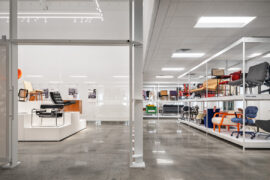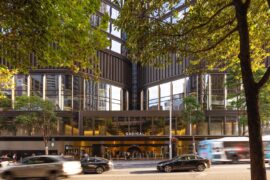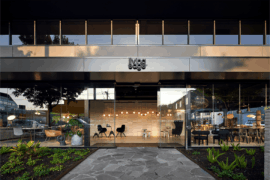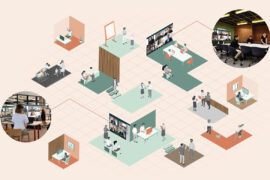With Tilt’s Tim Phillips having recently sat as a panellist on one of Saturday Indesign’s discussion events, we decided to dig a little deeper into sustainability with him.

(L-R): Clémence Carayol, Tim Phillips, Chris Fox and Nick Garnham, Saturday Indesign at Jardan, photography by Eugene David Grey.
September 19th, 2024
Tim Phillips is Managing & Creative Director of Tilt Industrial Design and recently appeared on a Saturday Indesign panel hosted by Jardan, ‘Sustainability from the start: How do you design with reuse in mind?’ The most effective approaches to sustainability today involve factoring it in from the very beginning of the design process. Instead of playing catch-up once the object is already made, the most forward-thinking designers are already working through reuse, recycling and circular economy before the sketching pencil has even left the page. We spoke to Tim for some further insight into these topics.
What factors determine how sustainable a project will be, and how are industrial designers uniquely placed to inform this?
Key factors include the product life-cycle, material performance specifications, budget considerations, client preferences, policy and contractual obligations, manufacturing location, and design for disassembly and recycling. Industrial designers are uniquely positioned to navigate these factors due to our comprehensive understanding of materials, manufacturing processes and product lifecycle management. We can advocate for sustainable choices, propose innovative end-of-life solutions, and help clients understand the long-term benefits of sustainable design.

Does scope for embedding sustainability vary across the sectors you work in, such as product development, public art, operable and custom architecture?
While core tenets of sustainable design remain consistent, implementation varies across fields. Product development might focus on materials innovation and efficient manufacturing, whilst public art projects prioritise durability and cultural sustainability. Operable and custom architecture often allow for more comprehensive strategies due to scale and budget. Despite these differences, common factors include considering the entire project lifecycle, material selection and future adaptability.
To what extent do recycling and circular design principles inform Tilt’s approach?
At Tilt, our approach is deeply informed by these principles but tailored to our projects’ typically long lifespans (15-25 years). We prioritise durability and low life-cycle maintenance, reducing the need for frequent replacements. We consider end-of-life scenarios, selecting recyclable materials and designing for easy disassembly. For shorter-lifespan projects, we might emphasise rapidly renewable materials or easy recycling. Our goal is to create designs that contribute to a circular economy, considering how they can be reintegrated into the production cycle at the end of their life.
Can you share a specific example of a project where sustainability principles were successfully implemented?
The PHIVE Civic Hub project in Parramatta showcases our approach. We designed a sophisticated shading system that improves the building’s thermal performance and livability, reducing the need for energy-intensive climate control. We chose aluminium for its durability and recyclability. Importantly, projects of this scale thoroughly analyse the impact of these systems in design to ensure real-world performance against sustainability objectives.

How can the design and construction industries more effectively embed sustainability principles into projects, and what role can technology play?
The future lies in combining advanced technology, holistic thinking and circular economy principles. Building Information Modeling (BIM) software is becoming invaluable for tracking material data throughout a project’s lifecycle, enabling more informed decisions about material choices. Advancements in materials science and engineering technologies such as finite element analysis (FEA) which support material use optimisation are opening new possibilities for sustainable design.
However, technology is a tool, not a solution itself. We need a fundamental shift towards circular thinking, considering a building or product’s entire lifecycle. This could manifest as design for disassembly or greater emphasis on adaptive reuse. The construction industry has significant potential to become more circular by better documenting and tracking materials, creating a more efficient market for reclaimed and recycled building materials.
Saturday Indesign
saturdayindesign.com
Tilt Industrial Design
tilt-industrialdesign.com
Jardan
jardan.com.au


INDESIGN is on instagram
Follow @indesignlive
A searchable and comprehensive guide for specifying leading products and their suppliers
Keep up to date with the latest and greatest from our industry BFF's!

The undeniable thread connecting Herman Miller and Knoll’s design legacies across the decades now finds its profound physical embodiment at MillerKnoll’s new Design Yard Archives.

Rising above the new Sydney Metro Gadigal Station on Pitt Street, Investa’s Parkline Place is redefining the office property aesthetic.
The new range features slabs with warm, earthy palettes that lend a sense of organic luxury to every space.

For Aidan Mawhinney, the secret ingredient to Living Edge’s success “comes down to people, product and place.” As the brand celebrates a significant 25-year milestone, it’s that commitment to authentic, sustainable design – and the people behind it all – that continues to anchor its legacy.

Across four decades, Leone Lorrimer LFRAIA GAICD reshaped Australian architecture through strategic vision, global influence and fearless leadership.

‘Come Together’ takes a global view of multigenerational design, an increasingly popular phenomenon with some especially notable examples in Australia.
The internet never sleeps! Here's the stuff you might have missed

Neill Johanson, Principal at Davenport Campbell, comments on what we might be losing and gaining with the expansion of remote work.

Rising above the new Sydney Metro Gadigal Station on Pitt Street, Investa’s Parkline Place is redefining the office property aesthetic.